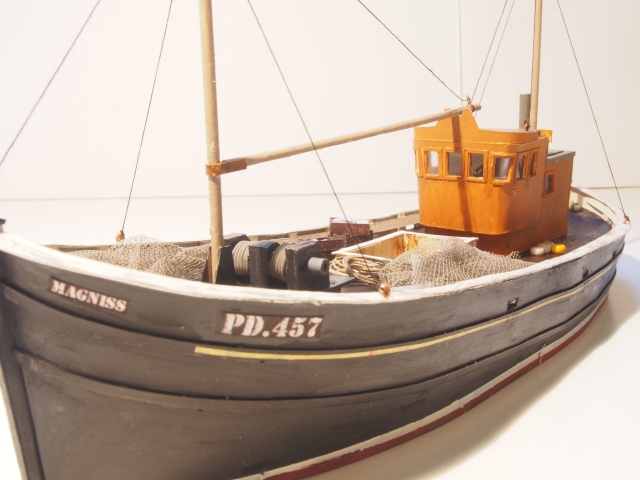
What I don’t know about boats can be written in a twenty-volume, leather-bound epic and anchored to a table in the National Maritime Museum. With certain exceptions, they are pretty well down my list of interesting types of transport. Add a few quayside railway lines into the mix, however, and suddenly you have a little magic – probably the result of snooping around the less salubrious parts of places like Oban, Mallaig, Stranraer and Dover as a kid…
There was always going to come a moment when the maritime side of this project needed to be faced – and it came sooner than expected, with the realisation that the second harbour scene risked being seriously held up as the boats would need to go in before the water was poured. Not that this is exactly a pressing priority – but I rather suspected that the production of a fishing fleet was not going to be a quick or cheap matter. I wasn’t wrong.
When the model was at the planning stage, the intention was to use the very nice kits from Artitec to deal painlessly with the need for high-detail craft. I was prepared to overlook the fact that they are under-scale, being to 1:87 rather than 1:76. As anyone who has tried mixing these scales will know, that small numerical difference amounts to something over 10% – enough to be noticeable. However, as I now know, boats come in all shapes and sizes and the plan was to use several, so that in the overall impression of a crowded fishing harbour, the discrepancy would go unnoticed. And they are very nice models.
But when it came to ordering the first one, it seemed as though much of Artitec’s 1:87 fleet is out of stock and/or production.
I began to look for alternatives – though the model boat fraternity seems to be afflicted with large numbers of obvious toys and then some exquisite kits – at exquisite prices – and mostly to scales far larger or smaller than of use to most railway modellers. I came back to one of the few other sources of boats for railway modellers – Scalescenes’ downloadable card kits. I’m not keen on printed detail and texture, but James Finister’s recent comments about his use of their barge kit made me look again.
There is no doubt that the kits are very well thought out, and extremely detailed for what they are. And they offer a fishing boat that does a very passable impression of what I now know is not a trawler but a Moray Firth seine netter – this being an entirely different method of luring unsuspecting herring and the like to an untimely end.
Scratch-building the boats had already been ruled out on ground of the aforementioned ignorance, not to mention the scary thought of all those complex curves in making boat hulls, even when you can only see what is above the water. But I began to wonder whether the Scalescenes kit might at least have solved these issues and might therefore be used not as a kit so much as a template for a semi-scratch-build.
I paid my £5.00 and downloaded the pdf. A trawl (seine?) through the plasticard mine revealed sufficient materials to have a go – and so it began. I used the Scalescenes sheets as templates for cutting the plasticard. While this add a couple of steps to the process, it is offset by there being no need to use all the double-sided printed overlays. Plasticard parts simply stand as they are and can be painted later. Likewise, constructing the hull is rather easier using solvent than card glue, since it dries much more quickly. I used .040 for most of the structure, and .030 black sheet for the hull itself. It worked well.
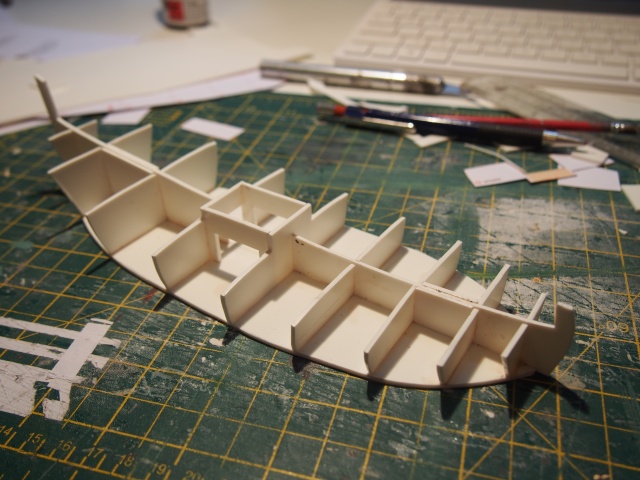
The ship yard at an early stage of the build.
The superstructure is an involved build, and it seemed to take ages to get nowhere with it. However, it did eventually start to come together. I took the opportunity to produce in 3D a lot of the detail that is only printed in the original kit. For example, the various hatches, grills and panels now all have relief. The cable on the winch drum is wound rather than printed. Lifebelts were carved from the solid, and a ship’s wheel was fashioned from plastic tube and brass wire for the wheelhouse. In a few cases, I used the original Scalescenes overlays but simply for their shape and then over-painted them. This yielded, for example, relief to the frames round the various cabin windows. I made an exception with some of the small interior details such as the control panel, where the dials etc. were used as printed.
In the meantime, I was spending worrying amounts of time on websites such as Fishing News and Trawlerpics.net from where it became apparent just how much clutter is to be found on the deck of the average small fishing vessel. The plan had always been to up-detail my version and hopefully take it some way further towards a fine scale model.
In addition to the foregoing, I therefore devised somewhat more plausible ways of anchoring the rigging than drilling through the mast – though I’m still not convinced that there is anything like enough. I already had a lifetime’s supply of tulle, and some of this, duly coloured up has made acceptable nets, while the donation of some small beads by my wife has provided floats.
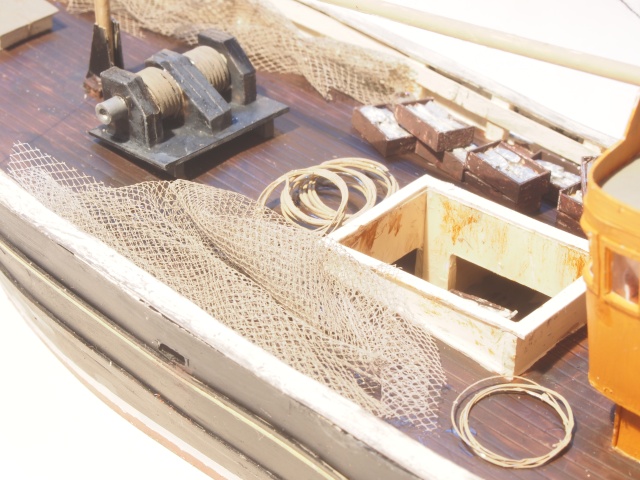
Still too tidy… The fish look as though they have rigor mortis – or perhaps they are actually Bird’s Eye shapes? But they look O.K. from normal distance.
Various gauges of fuse wire were coiled to represent the huge lengths that seem to feature in many photos – and as this boat is supposed to be unloading, the hold was modelled open, with a number of fish-boxes in the process of removal. Three days of pretty intense work and about 25 hours saw it done. I think there is still a lot more clutter needed on deck, though.
I have since been notified by the UK supplier that they do have a few of the Artitec kits left – so this may well be the route for the second vessel. However, as it is quite a lot smaller than the current build, there will be room for a twin of this one in due course. I think I may need to recover my sanity for quite some time first, though.
Reader, I’m sorry to say that I did yield to the temptation to produce individual fish to fill the boxes. I developed a patent way to mass-produce them that is as easy as wielding a fish-slice. Well, so much of this model is one way or another connected with the fishing industry that it seemed indecent not to give the little bloaters at least a walk-on part…
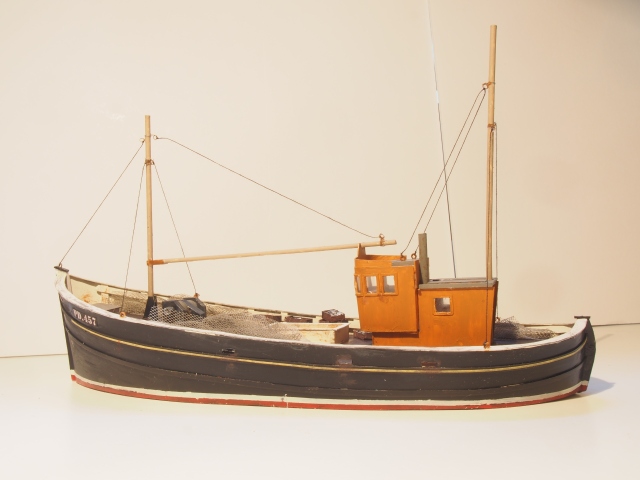
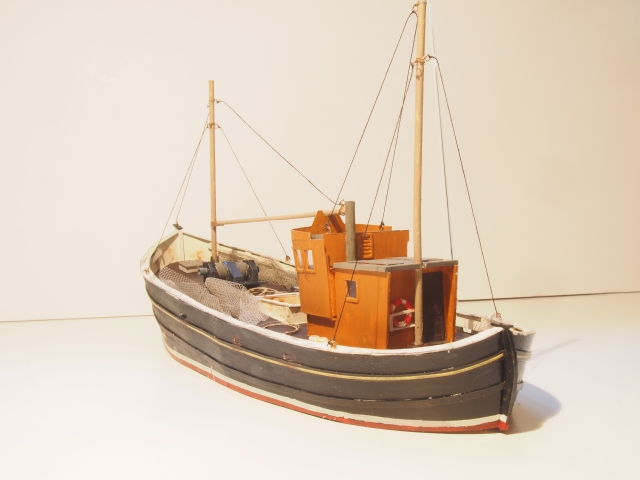

Nicely done. I think actually, you’ve been very lucky because that Scaelscenes model is just about right for your location and period. The wheelhouse might be a little modern. What it highlights for me, and this is part of a wider discussion for elsewhere, is how modellers deal with subjects outside of their “core competency.” Something might not be of interest to you, but that is no excuse for not researching it to the same standard as the railway. There was a heated argument on RMweb about a layout based on a specific location and period where the policeman was wearing a helmet when it should have been a cap, and the builder took umbrage and shouted “Rivetcounters” which as we know is deeply insulting
Thanks. I think you’re right about being lucky. I may not know much about boats but I did my homework to check it against numerous pictures. If you are aiming for accuracy, suddenly finding you have not a clue what to put in, or where, is quite disorientating. I still think there is more rigging needed – but I can’t work out what, as it just looks like a spider’s web in most of the photos I’ve seen – and apparently no diagrammatic guide to be found…